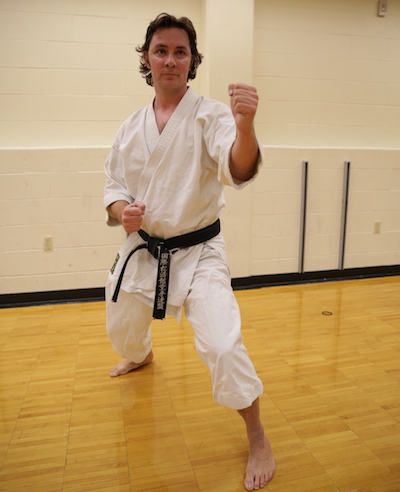Much of modern karate training can be done simply by refining one's technique through careful internal reflection. The only thing required is a karate uniform or do-gi. However, there can be great benefit to using equipment in training. The use of equipment can be vital for developing a method of direct feedback regarding the execution and delivery of power into a target. To this end, equipment can be used for two primary purposes: (1) understanding the internal feeling of the body as a technique impacts an object, and (2) developing focus and power delivery through correct alignment to a target outside the body.
The following is not an exhaustive list, just several of the vital methodologies and apparatus that are commonly used in most dojos. Note that he benefits of training equipment for conditioning the body are beyond the scope of this article.
Apparatus to Help Develop Internal Feedback
One of the key aspects of all karate training is to develop internal connection as well as correct body alignment of arms and legs. This is sometimes known as intra-abdominal pressure (IAP.) IAP occurs when the muscles of the lower abdomen, stomach, and back flex to create the walls of a box. Next, the karate practitioner breathes in such a way as to flex the diaphragm down to put pressure on the internal viscera, which pushes out on the walls of the box to make it solid. It is through this solid box that karate practitioners can connect their arms to the floor to generate power. Unfortunately, without feedback in some way—just training by punching the air, for example—the practitioner may be unable to develop this kind of body feeling.
Weights and Weight Training
One way to develop this type of feeling is to use light weights (one to five pounds max) or sai, in the hands, on the ankles, or on the trunk, increasing the weight over time. (The sai is a three-pronged metal truncheon weapon used in Okinawan martial arts.) Or a five- to fifteen-pound weight vest could be employed, using slow-motion techniques. This extra weight at the end of a lever causes the internal muscles to flex, and if practitioners pay attention to their body, they can get a feel for the contractions required by the various movements for karate. This will also allow the practitioner to become aware of the deep muscle contractions vital to proper technique. It is paramount that the practitioner use light weights, as anything too heavy will cause the incorrect muscles to be used; the weights should just serve as an amplifier for normal unweighted movement.
Partner
Another incredibly useful piece of training equipment is the partner. A partner can provide immediate feedback on techniques as they are executed. One partner-based technique widely used in other types of karate (goju ryu and Uechi ryu) is shime. This is often employed during the practice of sanchin kata, where trainees are slapped and pushed as they contract throughout the movement. This provides direct feedback on stability as well as on core and limb connection to that core. In Shotokan, we have only a single kata that can compare to the isometric heavy feeling of sanchin. That is the kata hangetsu. However, if we modify this type of training to achieve quick execution and release, characteristic of many Shotokan movements, we can derive benefits.
To do this, the same slapping motions (to the abdomen, back muscles, arms) can be used at the point of connection to see if the karateka is in fact using the correct muscles at the correct time.
Obi
One invaluable tool for developing internal feedback is the belt, or obi. The obi can be folded lengthwise in half, then in half again. One partner can then hold it in one hand approximately one foot down from the loop end. The folded obi then can represent a one- to two-inch midline from the top of the head to the bottom of the torso. The other partner can then kick, strike, and punch one to two inches into the obi, with good kime.
Impact Training
Impact training is important for understanding internal connection. For this, two major pad types are used: flexible light pads, such as clappers and hand-held focus mitts, and solid hard pads, such as body shields, heavy bags, partners with phone books in their gi, and punching posts or makiwara. The latter is important for both internal and external connection and will be addressed in the next section as well as here.
As one strikes a solid target, the target provides force directly back into the body, proportional to the force applied to the target. The force applied back can provide invaluable feedback regarding body connection, alignment, the use of intra-abdominal pressure, and the timing of all these related to the striking of the target. In order to get the maximum amount of feedback, it is important to hit a solid target that provides some flex, so as not to damage the body part striking it. Common apparatus include traditional makiwara, hung punching bags, and partners holding body shields and focus mitts. If the club does not have access to any of these items, a phone book placed inside the front of the karate gi may be used.
When hitting the target, it is important that the practitioner feel the impact traverse directly through the practitioner's body to the heel in contact with the floor. If impact or give is felt in any joint (wrist, elbow, shoulder, lower back, knee, or ankle), it is an immediate indication that the practitioner does not have correct body alignment.
Apparatus to Help Develop External Feedback
In addition to understanding how it feels to hit a target, it is also important to understand how to hit the target. This includes being able to do the calculus for correct targeting, technique, timing, and distance to the target.
Obi
One very useful piece of apparatus is the obi. The obi can be folded lengthwise in half, then in half again. One partner can then hold it in one hand approximately one foot down from the loop end. The folded obi then can represent a one- to two-inch midline from the top of the head to the bottom of the torso. The other partner can then kick, strike, and punch one to two inches into the obi, with good kime. (Kime is power and/or focus which describes the instantaneous tensing at the correct moment during a technique.)
Impact Apparatus
The use of pads, bags, and punching posts or makiwara are also useful for developing external feedback. It is important to have a percussive shock when striking the target, as this represents sharp kime. Quite often when striking targets, it can be easy to get sucked into the idea that a hard push is the same as a strike. Unfortunately, while feeling strong, a push can use antagonistic muscles that slow the technique and thus reduce the impact power.
If practitioners find themselves doing this, they need to adjust their distance back away from the target so that they just strike the surface of the pad. Once this is achieved, the practitioner may then gradually strike deeper into the pad, maintaining that feeling up to the distance equivalent to the length of their fist, approximately two to three inches. If at any point the technique becomes a push rather than a shock, the process needs to be repeated. An impact pad is also useful to distinguish keage techniques from kekomi techniques. When a pad or individual is hit with a keage technique, they should vibrate and stop dead where they are, while a kekomi technique should knock the pad or individual back on the same vector the technique is employed along.
While the use of air training is vital for identifying the correct course of movement, it is important to gain feedback from external sources. This helps the practitioner discern internal and external feelings within techniques.
The training equipment I have discussed here is widely available and can be very beneficial to one's training.
The above is an excerpt from Karate Science Dynamic Movement by J. D. Swanson, PhD.


